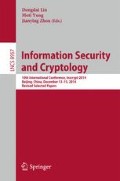Abstract
Micro Electro Mechanical Systems (MEMS) sensors (accelerometer, gyroscope, and compass) offer a practical approach for true random number generation. Entropy values of 0.99 close to theoretical value of 1, and large Kullback-Leibler distances were obtained in this study [1]. The main contribution of this work was the generation of high quality random number strings, when the MEMS sensor was at complete rest, a configuration in which these sensors were heretofore considered to be inadequate. This was accomplished by using the initial noise in the sensing mechanisms for the MEMS sensors. The compass output stream passed the highest number of NIST Tests; 11/15 and 14/15 under stationary and complete motion, respectively [2–4]. Short burst (<1 s) strings passed 13 out of 15 NIST tests, and applying the Barak-Impagliazzo-Wigderson recursive extractor led to successful results in all 15 NIST tests. Interleaving MEMS output with audio resulted in a string that passed 14 out of 15 NIST tests.
Access this chapter
Tax calculation will be finalised at checkout
Purchases are for personal use only
References
Leibler, R.A., Kullback, S.: On Information and Sufficiency. Ann. Math. Stat. 22, 79–86 (1951)
Von Neumann, J.: Various techniques used in connection with random digits. In: Forsythe, G.E., Germond, H.H., Householder, A.S. (eds.) Monte Carlo Method. Government Printing Office, Washington (1951)
Barak, B., Impagliazzo, R., Wigderson, A.: Extracting randomness using few independent sources. SIAM J. Comput. 36, 1095–1118 (2006). 4, Philadelphia USA: Society for Industrial and Applied Mathematics
NIST. Engineering and Statistics Handbook. s.l.: NIST (2012)
Whitfield, D., Hellman, M.: New directions in cryptography. IEEE Trans. Inf. Theory IT-22(6), 644–654 (1976)
Gartner: Forecast: PCs, ultramobiles and mobile phones 2014. Gartner Group, Egham (2014)
Llamas, Ramon T.: Worldwide Wearable Computing Device 2014–2018 Forecast and Analysis. IDC, Boston (2014)
Invensense Annual Report, Form 10-K. San Jose, CA, USA: s.n., March 2014
Voris, J., Saxena, N., Halevi, T.: Accelerometers and Randomness: Perfect Together. ACM, Hamburg, Germany (2011). WiSec
Dodis, Y., Pointcheval, D., Ruhault, S., Vergnaud, D., Wichs, D.: Security analysis of pseudo-random number generators with input. In: ACM Conference on Computer and Communication Security. ACM, Berlin, Germany (2013)
Barak, Boaz, Shaltiel, Ronen, Tromer, Eran: True random number generators secure in a changing environment. In: Walter, Colin D., Koç, Çetin Kaya, Paar, Christof (eds.) CHES 2003. LNCS, vol. 2779, pp. 166–180. Springer, Heidelberg (2003)
Wang, X., Xue, Q., Lin, T.: A novel true random number generator based on mouse movement and a one dimensional chaotic map. s.l. Math. Prob. Eng. 2012, 12 (2012). Hindawi Publishing
Chen, I.T.: Random numbers generated from audio and video sources s.l. Math. Prob. Eng. 2013, 7 (2013). Hindawi Publishing
Lauradoux, C., Ponge, J., Roeck, A.: Online Entropy Estimation for Non-Binary Sources and Applications on iPhone. Institut National de Recherche en Informatique et en Automatique, pp. 19–42 (2011)
Mayrhofer, R., Groza, B. (eds.): Simple accelerometer based wireless pairing with heuristic trees. In: Proceedings of the 10th International Conference on Advances in Mobile Computing and Multimedia. ACM (2012)
Studer, A., Timothy, P., Bauer, L.: Don’t bump, shake on it; the expoitation of a popular accelerometer-based smart phone exchange and its secure replacement. In: Proceedings of the 27th Annual Computer Security Applications Conference, pp. 333–342. ACM, New York (2011)
Chagnaadorj, O., Tanaka, J.: MimicGesture: Secure Device Pairing with Accelerometer-Based Gesture Input. In: Han, Y.-E., Park, D.-S., Jia, W., Yeo, S.-S. (eds.) Ubiquitous Information Technologies and Applications. Lecture Notes in Electrical Engineering, vol. 214, pp. 59–67. Springer, Heidelberg (2013)
Zhou, Q., Liao, X., Wong, K., Hu, Y., Xiao, D.: True random number generator based on mouse movement and chaotic hash function s.l. Inf. Sci. 179, 3442–3450 (2009). Elsevier
Nasiri, Steven: A Critical Review of MEMS Gyroscope Technology and Commercialization Status. Invensense Inc, San Jose (2006)
Nasiri, S.: Wafer-Scale Packaging and Integration Are Credited for New Generation of Low-Cost MEMS Motion Sensor Products. Invensense, San Jose (2006)
Daneman, M., Lim, M., Assaderaghi, F.: Evolution of MEMS towards a semiconductor model. Hearst Business Coummunications, New York (2012)
Nasiri, S., Seeger, J., Yaralioglu, G.: 20080314147 Saratoga, California (2008)
Qiu, J., Seeger, J., Castro, A., Tchertkov, I., Li, R.: 20120125104 Sunnyvale, California (2012)
Seeger, J., Nasiri, S., Castro, A: 2010132460 Menlo Park, USA (2010)
Dixon-Warren, J.: MEMS J (February 2011). www.memsjournal.com
MEMS Sensors; How it works technically. MEMS Central (2014). http://memscentral.com/Secondlayer/mems_motion_sensor_perspectives-2.htm. Accessed 20 July 2014
Silicon Designs. Silicon Designs (2014). http://www.silicondesigns.com/tech.html. Accessed 20 July 2014
Invensense MPU 9250 SDK. Invensense Inc, San Jose, California (2013)
Cover, T.M., Thomas, J.A.: Entropy, Relative Entropy and Mutual Information. Elements of Information Theory, pp. 12–25. John Wiley and Sons, New York (1991)
A Statistical Test Suite For Random and Pseudorandom Number Generators For Cryptographic Applications. National Institute of Standards and Technology, Gathiersburg, Maryland, USA (2010)
Acknowledgments
The authors would like to thank Professor John Steinberger for helpful discussions and support through the summer internship. This work was performed at Tsinghua University, Institute for Interdisciplinary Information Sciences, Beijing, China and their support is greatly appreciated. The authors also appreciate the support of Cameron Ballingall and InvenSense Inc., which provided the MEMS sensors used in this study. The authors would also like to thank the reviewers for their comments and suggestions.
Author information
Authors and Affiliations
Corresponding author
Editor information
Editors and Affiliations
Rights and permissions
Copyright information
© 2015 Springer International Publishing Switzerland
About this paper
Cite this paper
Bedekar, N., Shee, C. (2015). A Novel Approach to True Random Number Generation in Wearable Computing Environments Using MEMS Sensors. In: Lin, D., Yung, M., Zhou, J. (eds) Information Security and Cryptology. Inscrypt 2014. Lecture Notes in Computer Science(), vol 8957. Springer, Cham. https://doi.org/10.1007/978-3-319-16745-9_29
Download citation
DOI: https://doi.org/10.1007/978-3-319-16745-9_29
Published:
Publisher Name: Springer, Cham
Print ISBN: 978-3-319-16744-2
Online ISBN: 978-3-319-16745-9
eBook Packages: Computer ScienceComputer Science (R0)

